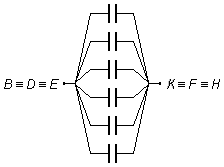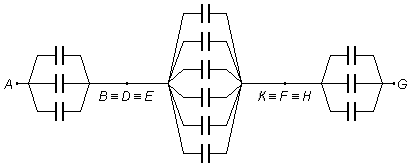Solved Problem on Capacitors
advertisement
Twelve capacitors with a capacitance equal to C are used to build the edges of a cube, as
shown in the figure. Determine the equivalent capacitance between points A and G
that is the diagonal of the cube.

Solution
We assume that capacitors are already charged, neglecting the transient during the time of charge of the capacitors.
Point A is a circuit node, the potential differences between points A and B,
A and D, A and E are the same, therefore points B, D,
and E represent the same point in the circuit,
\( B\equiv D\equiv E \).
The three capacitors "come out" from common point A and "arrive" in the common point
\( B\equiv D\equiv E \),
so these three capacitors are in parallel (Figure 1).

The three capacitors between points K and G, F and G, H and
G are also with the same potential differences, points K, F, and H
represent the same point in the circuit
\( K\equiv F\equiv H \).
The capacitors "leave" from the common point
\( K\equiv F\equiv H \)
and "arrive" in the common point G. These are also in parallel (Figure 2).


The cube circuit is equivalent to a flat circuit. There are three capacitors in parallel, in series with six capacitors in parallel and in series with three more capacitors in parallel (Figure 4).

Let's call C1 the equivalent capacitance between points A and \( B\equiv D\equiv E \), and C3 the equivalent capacitance between points \( K\equiv F\equiv H \) and G, these parts of the circuit are equal, so C1 = C3. The expression to determine the equivalent capacitance of an association of n equal capacitors in parallel is
\[
\begin{gather}
\bbox[#99CCFF,10px]
{C_{eq}=nC}
\end{gather}
\]
for n = 3
\[
\begin{gather}
C_1=C_3=3C
\end{gather}
\]
Note: we could also determine the equivalent capacitance by applying the expression
for the association of capacitors in parallel
\[
\begin{gather}
C_{eq}=\sum_{i=1}^{n}C_{i}\\[5pt]
C_1=C_3=C+C+C\\[5pt]
C_1=C_3=3C
\end{gather}
\]
Between the points \( B\equiv D\equiv E \) and \( K\equiv F\equiv H \) we have six equal capacitors in parallel we will call the equivalent capacitance between these points C2, applying the expression to the association in parallel of capacitors, with n = 6, we have
\[
\begin{gather}
C_2=6C
\end{gather}
\]
Note: applying the expression for the association of capacitors in parallel
\[
\begin{gather}
C_2=C+C+C+C+C+C\\[5pt]
C_2=6C
\end{gather}
\]
So the circuit is reduced to the following

The equivalent capacitance of the circuit Ceq will be the sum of the capacitors in series
\[
\begin{gather}
\bbox[#99CCFF,10px]
{\frac{1}{C_{eq}}=\sum _{i=1}^{n}{\frac{1}{C_i}}}
\end{gather}
\]
\[
\begin{gather}
\frac{1}{C_{eq}}=\frac{1}{C_1}+\frac{1}{C_2}+\frac{1}{C_3}\\[5pt]
\frac{1}{C_{eq}}=\frac{1}{3C}+\frac{1}{6C}+\frac{1}{3C}
\end{gather}
\]
the common factor between 3C and 6C is 6C
\[
\begin{gather}
\frac{1}{C_{eq}}=\frac{2+1+2}{6C}\\[5pt]
\frac{1}{C_{eq}}=\frac{5}{6C}
\end{gather}
\]
\[
\begin{gather}
\bbox[#FFCCCC,10px]
{C_{eq}=\frac{6C}{5}}
\end{gather}
\]
advertisement

Fisicaexe - Physics Solved Problems by Elcio Brandani Mondadori is licensed under a Creative Commons Attribution-NonCommercial-ShareAlike 4.0 International License .